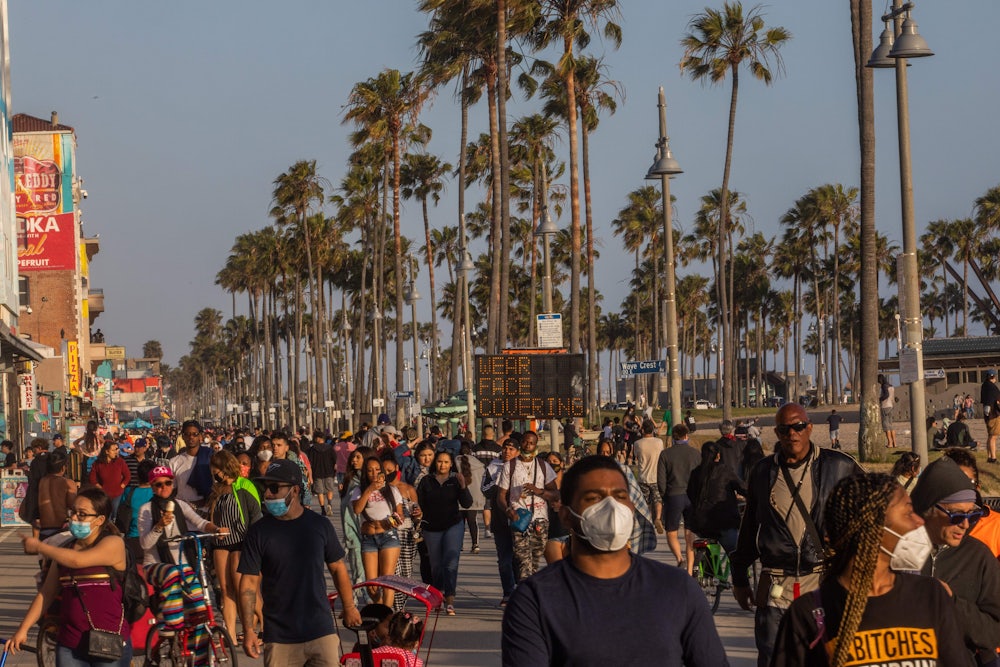The number of coronavirus cases in the United States has continued to climb in at least 23 states and reached record highs this week in Florida, Texas, and Oklahoma, among other places. By the end of June, well over 2.3 million people in the country will have been infected, and more than 122,000 people will have died. We remain very much in the middle of a pandemic, but you’d be forgiven for thinking otherwise. Earlier this month, Albertsons—the second-largest grocery chain in the nation, with locations in several states where cases are on the rise—ended its so-called “hero pay,” or a temporary raise of $2 per hour, for store workers. Walmart plans to end hazard pay for its workers on July 3; Stop and Shop will end it on July 4. (How patriotic!) “We are deeply grateful for how our front-line associates served their neighbors in an extreme time of need,” Albertsons, whose profits tripled this year, said by way of a nonresponse to criticism from its workers’ union.
In lockdown, time often seems to stand still or else vanish completely. But the clock is ticking not just for hazard pay for essential workers in the private sector but also for the few federal protections passed by Congress at the end of March that have prevented a complete economic collapse. In a few short months, when several necessary provisions in the government’s relief package expire and medical bills and other financial obligations arrive, a new kind of crisis will begin for millions of Americans.
By the end of July, the extra unemployment payments granted to laid-off workers by the Cares Act, which amount to an additional $600 per week, are set to expire, despite the fact that the most recent available data from the May jobs report put the unemployment rate at 13 percent, with more than 20 million people still out of work and black and Latinx workers hit especially hard. Republicans, for their part, have vowed to fight any attempts to extend those benefits, and several are even looking to convert them into bonuses for people who return to their jobs—essentially incentivizing the flouting of public health guidelines. “The president is looking at a reform measure that would still provide some kind of bonus for returning to work, but it will not be as large and it will create an incentive to work,” Trump adviser Larry Kudlow said last week.
By the end of August, the federal moratorium on home foreclosures and renter evictions, which protect residents living in homes financed by federally backed mortgages—one in four rental units—will also expire. Statewide eviction protections in places such as Arizona and California expire at the end of July; in Florida, Virginia, Connecticut, and elsewhere, state-level eviction protections expire on or before July 1. The end of such orders are premature, to say the least: According to one estimate, nearly a third of Americans missed rent in June, and housing researchers and advocates have predicted a spike in homelessness if federal and state governments decline to extend housing protections. “A lot of people could be on the streets,” Aaron Carr, the executive director of the Housing Rights Initiative, recently told CNBC.
By the end of September, the Cares Act’s six-month freeze on federal student loan payments will expire, forcing up to 40 million borrowers to resume monthly payments even though unemployment is projected to remain in the double digits through the end of the year. Those unable to make payments on their student loans or other debts could see their bank accounts frozen or find themselves subject to harassment from debt collectors. And the fall, as it happens, is also when some epidemiologists have cautioned that a second wave of the coronavirus could begin again. “We are filling the stockpile in anticipation of a possible problem in the fall,” Trump’s own trade adviser, Peter Navarro, told CNN on Sunday, a few days after Mike Pence bluffed in the pages of The Wall Street Journal, “The media has taken to sounding the alarm bells over a ‘second wave’ of coronavirus infections. Such panic is overblown.”
The growing concern over a second wave, though, isn’t limited to just the outbreak itself. Another economic shutdown would be a disaster for workers already struggling to make ends meet, particularly those employed in precarious occupations. “Right now I’m not working,” Julio Sibri, a New York cab driver told The New Republic at the end of May. “A lot of other cab drivers aren’t working at the moment, either, because people just aren’t out, and no one can pick up fares.” Rosana Araujo, an undocumented domestic worker, echoed that sentiment: “There’s still no pardon for rent or utilities, and there’s no jobs available,” she said.
The immense tragedy and cruelty of the economic misery that’s likely to unfold over the next few months is that, unlike the pandemic itself, this kind of suffering is mostly preventable. Though the stimulus bill was meager compared to other countries’ relief programs—and was hindered by a number of delays and administrative problems and off-limits to undocumented immigrants—it also helped millions of people avoid a total freefall into destitution. “What we’re doing has been largely successful, but families could find themselves in big trouble in the fall after it expires,” one poverty researcher at Columbia University told The New York Times on Monday. That the poverty rate reliably dwindles when governments intervene demonstrates the extent to which economic apocalypse is man-made, not an act of God. The Senate, which is scheduled to consider a new stimulus proposal after a two-week recess in July, will have a chance to stave off more hardship. But time’s running out.
